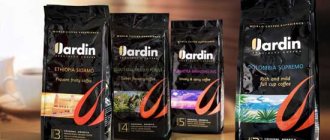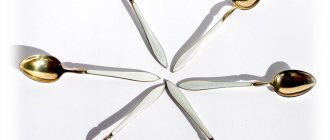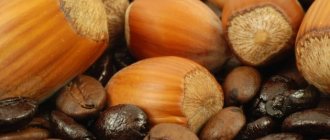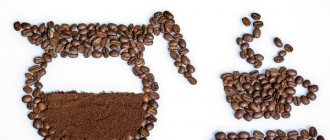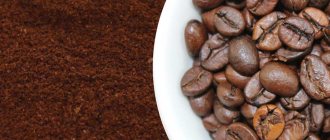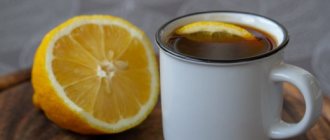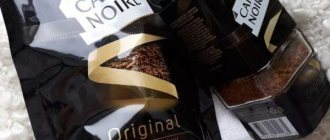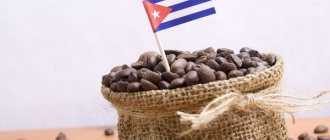Description and features
The cute animal has a slender and long body with short limbs. The musang in the photo gives the impression of being a hybrid of a cat and a ferret. The gray fur is thick, hard on top, with a soft undercoat inside.
The back is decorated with black stripes, the fur is marked with dark spots on the sides. The ears and paws are always darker; the black elongated muzzle has a characteristic white mask or white spots. Slight differences in color appear among species in different habitats.
The animal has a wide head, a narrow muzzle, with large, slightly bulging eyes, and a large nose. Small rounded ears set wide apart. A real forest musang hunter is armed with sharp teeth and claws on strong paws, which the predator hides in its pads as unnecessary, like a domestic cat. The dexterous and flexible animal is an excellent climber and lives mainly in trees.
The length of a mature musang is approximately 120 cm from the nose to the tip of the tail, the size of which is more than half a meter. The weight of an adult varies from 2.5 to 4 kg. The scientific description of the species includes the concept hermaphroditus, which was erroneously attributed to the musang because of the protruding glands in males and females that resemble the shape of the gonads of males.
Most of the time the musang lives in trees
Later they found out that the purpose of the organ is to mark the territory of home areas with secretions, or odorous contents with the smell of musk. No pronounced differences are observed between males and females.
How to brew Luwak coffee
Luwak coffee in its homeland is never brewed in coffee machines, coffee pots, or in a Turkish coffee pot. There, the beans are ground to a powder, poured into a metal filter, placed on a coffee cup, and then boiling water is poured and they wait for the drink to pour drop by drop into the substituted container. If you follow all the traditions, then you need to add 2-3 ice cubes to a cup of coffee and be sure to wash this drink down with green tea.
Outside the countries in which Luwak is made, it is brewed using more modern methods, that is, it is mainly boiled in a Turk. It is prepared as follows:
- Filtered cold water is poured into the Turk.
- Coffee beans are ground and one teaspoon is poured into a cup of water.
- For good foaming, you need to put a few crystals of salt in the pot with boiling coffee.
- The light foam that forms during boiling must be carefully removed and placed in a cup. As soon as it begins to approach the edges of the Turk, the container must be removed from the heat, pour the coffee into a cup and stir.
Be sure to read: How to make coffee with ginseng at home
True experts and connoisseurs claim that Luwak can sometimes be combined with condensed milk, ginger root, spicy cloves, and cardamom.
Kinds
In the Vivverov family, there are three main types of musangs based on differences in fur color:
- The Asian Musang is distinguished by pronounced black stripes on gray fur throughout the body. On the animal’s belly, the stripes turn into spots of a lighter color;
- The Sri Lankan musang is classified as a rare species with colors ranging from dark brown to reddish, from light golden to reddish-golden. Sometimes individuals appear with a faded light beige color;
- The South Indian Musang has an even brown color with slight darkening in the head, chest, paws, and tail. Some individuals are decorated with gray hair. There are different coat colors: from pale beige shades to deep brown. The tail is often marked with a yellowish or white tip.
There are much more subspecies, numbering about 30. Scientists classify some subspecies living on the islands of Indonesia, for example, Ph philippensis, as separate species.
Taste of Luwak coffee
The color of the beans ready for cooking is much darker than Arabica beans. The smell of the grains resembles chocolate, and the finished Luwak tastes like caramel. In its finished form, the taste of Luwak differs sharply from traditional coffee, since it has a soft, pleasant taste, which does not have the bitterness and sour aftertaste that are usual for all other varieties.
Important! When undiluted, Luwak coffee is overly rich and thick.
Luwak should be drunk without any additional components - sugar, cream or milk and not snacked on anything. Otherwise, it may lose its unique taste and cease to differ from other varieties.
Lifestyle and habitat
Palm martens live in tropical and subtropical moist forests across the vast territory of Indochina and numerous islands of South Asia. In mountainous areas, the animal lives at altitudes of up to 2500 meters. The natural habitat of animals is in Malaysia, Laos, Cambodia, Vietnam, Thailand. In many places the musang animal is an introduced species. The animals acclimatized in Japan, Java, and Sulawesi.
Palm martens are active at night. During the daytime, animals sleep in hollows and on branchy forks. Palm martens live alone; only during the breeding season does communication with individuals of the opposite sex begin.
The animals are very common, appearing in parks, garden plots, and farms, where martens are attracted to fruit trees. If a person treats forest guests peacefully, then musangs inhabit stables, roofs, and attics of houses.
In some countries, musangs are kept as pets.
They reveal their appearance by being active at night, which often irritates their owners. In houses where musangs live as pets, there are no rats or mice, with which representatives of civets deal brilliantly. In relation to their owners, palm martens are affectionate, good-natured, and flexible.
Nutrition
Predatory animals are omnivores - their diet includes both animal and plant foods. Malayan forest dwellers hunt small birds, destroy nests, catch insects, larvae, worms, and small rodents from the squirrel family.
Palm martens love to eat sweet plant fruits and various fruits. Animals have been noted to have a predilection for fermented palm sap. Local residents are also familiar with this taste - Toddy wine, similar to liqueur, is made from the juice. In captivity, pets are fed meat, chicken eggs, low-fat cottage cheese, a variety of vegetables and fruits.
The main food craving for which musangs have become famous is the fruit of the coffee tree. Animals, despite their love for coffee beans, are selective. The animals feast on only the ripest fruits.
In addition to coffee beans, musangs love to eat sweet tree fruits.
Musang diet
The main, predominant part of the diet of Sri Lankan musangs is represented by all kinds of fruits . Predatory animals with great pleasure eat quite a large number of mangoes, coffee, pineapples, melons and bananas. Occasionally, palm martens also eat various small vertebrates, including not too large birds and snakes, as well as lizards and frogs, bats and worms. The diet of adult musangs also includes a wide variety of insects and fermented palm sap called toddy, which is why locals often call such animals toddy cats. Occasionally, animals settling near human habitation steal all kinds of poultry.
Classified as omnivores, mussangs consume a wide variety of food types, but have become famous for consuming grain from coffee plantations. Such undigested grains make it possible to obtain the most delicious and most expensive type of coffee, Kopi Luwak. When eating coffee fruits, the animals excrete them in almost undigested, pure form. However, under the influence of natural enzymes, some processes take place in the intestinal tract of the musang that significantly improve the quality characteristics of coffee beans.
Return to content
Reproduction and lifespan
The Musang animal leads a solitary lifestyle, meeting with individuals of a different sex 1-2 times a year only for reproduction. Young palm martens reach sexual maturity at 11-12 months. The peak birth rate in the subtropics occurs from October to December. In the tropical zone, reproduction continues year-round.
Mating of animals occurs on tree branches. Males and females do not stay together for long. The worries of bearing and raising offspring lie entirely with the musang mothers. Gestation lasts 86-90 days, in some species 60 days, in a litter of 2-5 cubs, each of which is born weighing approximately 90 g.
Before the babies appear, the female prepares a special nest for herself in a deep hollow. The mother feeds newborn babies with milk for up to two months, later the female teaches the babies to hunt and get their own food, but gradually feeds the offspring.
Pictured is a baby musang
In some species, the period of feeding on milk extends to up to a year. In general, attachment to the mother sometimes lasts up to a year and a half, until young musangs gain confidence in obtaining food during night forays.
Later they go in search of their own habitats. The lifespan of animals in the natural environment is 7-10 years. Pets in captivity, if well cared for, live up to 20-25 years.
In the Red Book, the common musang subspecies P. hermaphroditus lignicolor is listed as a vulnerable species. One of the reasons is the constant hunting of animals due to their food addiction to coffee beans and fermentation, thanks to which they obtain a drink of rare quality.

